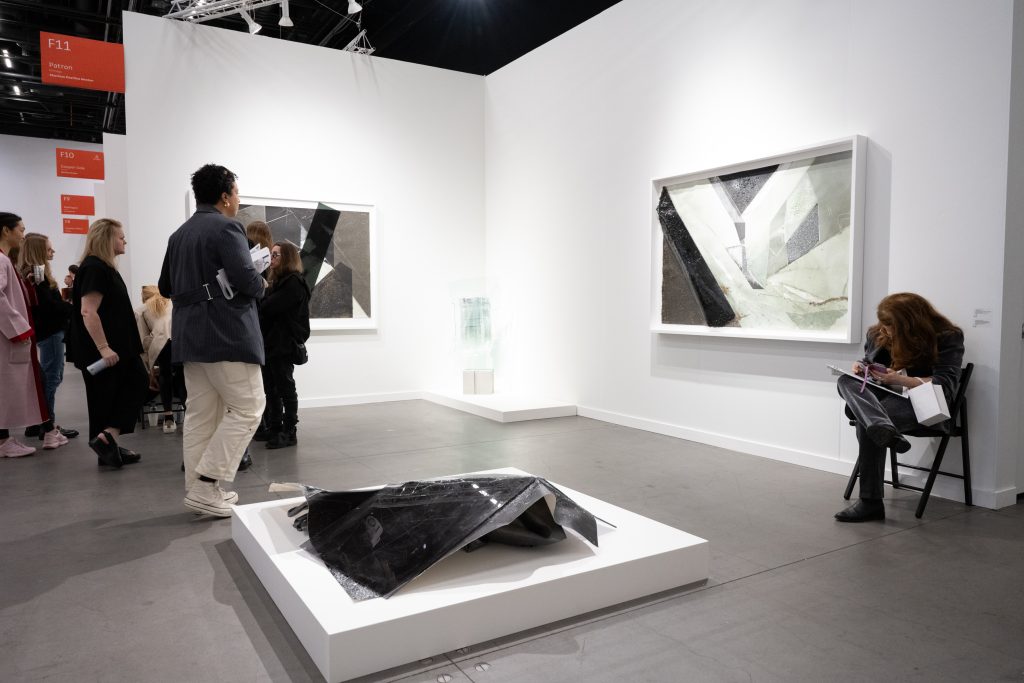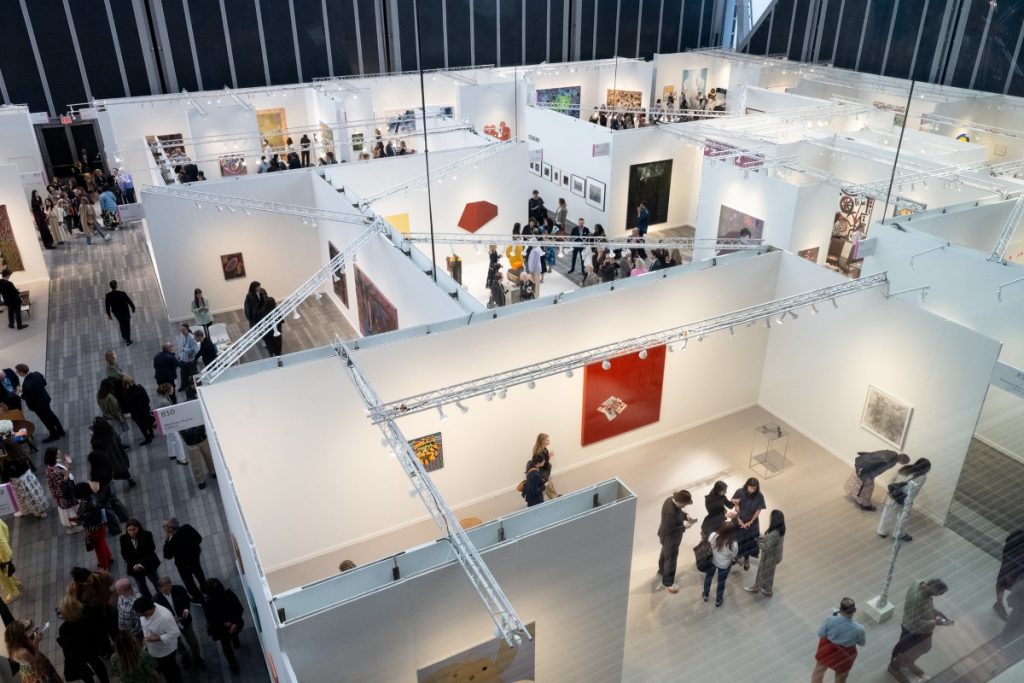Frieze New York — an event that was actually similar in size to other art gatherings that I attended around the same time but that somehow felt the largest and/or most sweeping. Probably, I’d guess, that’s in part because of its location: a venue in New York City’s Hudson Yards neighborhood called The Shed — a large, hulking building.
Frieze was split into a series of sections, including “Focus,” which translated to 11 galleries on the fourth floor that all — refreshingly — had solo presentations, meaning selections of works from a single artist at a time.
Carmézia Emiliano at Central Galeria
A definite standout from the “Focus” galleries were bright paintings by Carmézia Emiliano presented by Brazil’s Central Galeria.
The paintings hearken to life among indigenous communities: specifically, the Macuxi, as the gallery explained in comparatively extensive informational cards (another nice element!). (Emiliano is part of this group.)
The works were all rather direct and striking. Evenly — and brightly — lit, the images depict their communities engaged in everyday activities and hearken to spiritual beliefs and traditions.
One example, “Tree of Life,” depicts at center the titular tree — which towers massively over figures down below engaged in the process of cutting it down. (It’s depicting a legend, the gallery elucidated.) Birds in the tree’s sweeping, huge branches are, in our view, the same size or even larger than those figures, using those shifting proportions to draw our focus to the abundance the tree offers that hangs in the balance in this scene.
From the horizon in the background to the many fruits on the tree, the color palette is both bright and richly forceful, making the scene — and scenes across Emiliano’s other paintings, which hinge on similar elements — come further to life. Across the booth, I was contemplating how the works visually seemed insistently direct, rhythmically moving towards the viewer in a steady, smooth progression. Emiliano shared a talent for presenting themes even as far-reaching as those in “Tree of Life” as something quite personal and accessible.

Charisse Pearlina Weston at Patron
I recently saw a large work by artist Charisse Pearlina Weston as part of this year’s edition of the Whitney Biennial: a large swathe of glass hanging, what looks like precariously, over visitors. (It’s obviously perfectly secure, and you can walk underneath part of it). I rather enjoyed the ambition of it, and I was pleasantly surprised to find more work by Weston in the Frieze “Focus” section thanks to Patron, a Chicago gallery.
Alongside other materials, Weston was again working with glass. “Weston’s interrogation into the materials of glass, language, and photography embraces precarity, obfuscation, and collapse as mediums through which to explore the social construction of Black interiority,” Patron explained online.
I was thinking awhile about “Edge Circuit III (on the balance, after collapse),” a 2024 work whose materials apparently include: photographic print on Hahnemüle canvas etched with glass from collapse, tempered and laminated glass panels shattered through the fold, frit, epoxy, and lead. Some of the glass is one of the most visible components, as it’s atop the free-standing, sculptural assortment of composite elements, which was presented low to the ground.
The visuals of the broken glass were striking, creating a jagged, tense, and sharp rhythm that was also ultimately soaring once you got to portions of the surfaces still somewhat intact. For some reason, the choral but piercing nature of the visual dance across the piece reminded me of church steeples and what such structures feel like when standing there.
I was also briefly reminded of a 2022-2023 exhibition at NYC’s New Museum showcasing artist Theaster Gates, who similarly incorporates elements otherwise used in literal construction projects, finding something spiritual within them.
I felt like Weston’s usage of glass gave her Frieze pieces a lot of inward space as she artfully deployed those elements to the material. It was like putting personal, spiritual contemplation — where emotional contortion can lead to clarity — on the same wavelength as physical elements operating fully externally. A church of the self, maybe — hints of a solitary figure morphing into a startling expanse.
Check out that piece here.

Hasani Sahlehe at Tif Sigfrids
Tif Sigfrids, a gallery apparently with presences in Athens, Georgia and New York, was presenting a series of acrylic gel paintings from artist Hasani Sahlehe. How could I not like these?
The artworks, all rather large, featured grids-of-sorts (abstract grids, I’m your biggest fan). While I do tend to like works with more coarse texture — like some of the jute I saw elsewhere at fairs, the flowing, soaring scope of these won me over. The gel material that Sahlehe was using meant the surfaces were rather smooth, with evidence of artistic involvement — they weren’t made to look precise in terms of mathematical precision — but no brush strokes or similar physical demarcation that an artist was here.
One of the grids on display utilized a vibrant gold color for several horizontal bars, which was splendid, while another combined a rich, rather dark red with startlingly vibrant yellow.
I think the red-and-yellow combo touched on a thread that I was feeling across the works, as they gave a bright, uplifting backing to a rather palpable intensity, extending its reach off into the metaphorical distance. The artfully imperfect symmetry of the paintings’ grid formations got to the same place, ultimately.
Think, perhaps, of the more intense threads of a sunset for a real-world parallel of some of this. Though not aggressive, it’s definitely intense, added to by the nature of the gel material, which looks caught in some kind of eternal shift across the surface, like a physical melt that’s forever frozen in place. It’s a hilltop of forward-looking energy, shot through by invigorating strain. And apparently, they all sold.

Featured image: Frieze New York 2024; Photo by Casey Kelbaugh. Courtesy of Frieze and CKA.
You may also like
-
Diana Kurz at Lincoln Glenn in New York: A Review of a Shining Art Exhibition
-
Dustin Hodges at 15 Orient in New York City: An Ensnaring Exhibition at an Exciting Gallery
-
Maren Hassinger at Susan Inglett Gallery in New York: Reviewing an Uplifting Art Exhibition
-
Enzo Shalom at Bortolami in New York City: Reviewing an Entrancing Exhibition of Paintings
-
“Ben Werther: Townworld” at Amanita in New York City: Reviewing a Richly Memorable Art Exhibition
